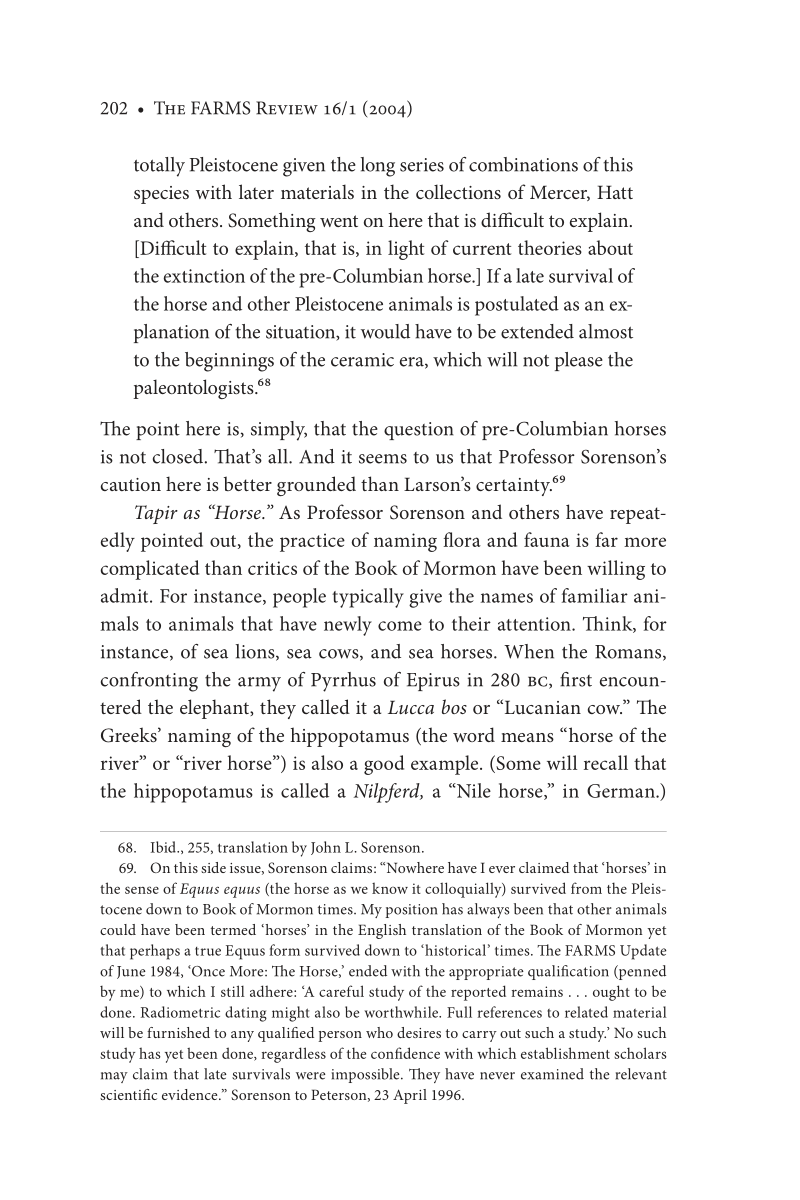Daniel C. Peterson and Matthew Roper discuss plausibility of BOM "horses" being Mesoamerican tapirs.
- Type
- Academic / Technical Report
- Hearsay
- DirectSecondary
- Reference
Daniel C. Peterson and Matthew Roper, "Ein Heldenleben? On Thomas Stuart Ferguson as an Elias for Cultural Mormons," FARMS Review of Books 16, no. 1 (2004): 202-204
- Scribe/Publisher
- Foundation for Ancient Research and Mormon Studies
- Audience
- Latter-day Saints, Reading Public
- Transcription
Tapir as “Horse.” As Professor Sorenson and others have repeatedly pointed out, the practice of naming flora and fauna is far more complicated than critics of the Book of Mormon have been willing to admit. For instance, people typically give the names of familiar animals to animals that have newly come to their attention. Think, for instance, of sea lions, sea cows, and sea horses. When the Romans, confronting the army of Pyrrhus of Epirus in 280 BC, first encountered the elephant, they called it a Lucca bos or “Lucanian cow.” The Greeks’ naming of the hippopotamus (the word means “horse of the river” or “river horse”) is also a good example. (Some will recall that the hippopotamus is called a Nilpferd, a “Nile horse,” in German.)
When the Spanish first arrived in Central America, the natives called their horses and donkeys tzimin, meaning “tapir.” The Arabs’ labeling of the turkey as an Ethiopian or Roman rooster (dīk al-˙abash or dīk rūmī), the Conquistadors’ use of the terms lion and tiger to designate the jaguar, and the fact that several Amerindian groups called horses deer represent but a few more examples of a very well-attested global phenomenon. The Nephites too could easily have assigned familiar Old World names to the animals they discovered in the New.
Larson dismisses Sorenson’s suggestion that the Mesoamerican tapir may have been considered by some Book of Mormon writers to be a kind of “horse” or donkey, declaring that the tapir is much more like a pig (pp. 192–93). Here, though, it is important to remember that Sorenson was comparing the horse to the larger Mesoamerican tapir (Tapiris bairdii) and not one of the smaller species. It is also noteworthy that Sorenson is not the only scholar to suggest the similarity. Kamar Al-Shimas notes that in contrast to pigs, the tapir is one of the cleanest of animals. Hans Krieg likewise feels that the comparison with the pig is unfortunate.
Whenever I saw a tapir, it reminded me of an animal similar to a horse or a donkey. The movements as well as the shape of the animal, especially the high neck with the small brush mane, even the expression on the face is much more like a horse’s than a pig’s. When watching a tapir on the alert, . . . as he picks himself up when recognizing danger, taking off in a gallop, almost nothing remains of the similarity to a pig.
“At first glance,” note Hans Frädrich and Erich Thenius, “the tapirs’ movements also are not similar to those of their relatives, the rhinoceros and the horses. In a slow walk, they usually keep the head lowered.” When one observes them running, however, this changes:
In a trot, they lift their heads and move their legs in an elastic manner. The amazingly fast gallop is seen only when the animals are in flight, playing, or when they are extremely excited. The tapirs can also climb quite well, even though one would not expect this because of their bulky figure. Even steep slopes do not present obstacles. They jump vertical fences or walls, rising on their hindlegs and leaping up.
While most species of tapir are much smaller, Baird’s tapir, the Mesoamerican species native to Mexico and Guatemala, is rather large. Adult tapirs of this species are about a meter high, nearly two meters in length, and can weigh over 300 kilograms. As one authority notes, “This is the largest of the Tapirs, equaling a small donkey in bulk and sometimes almost so in size.” Likewise, A. Starker Leopold describes Baird’s tapir as “the size of a pony but chunkier and with much shorter legs.” Ernest P. Walker describes them as “about the size of a donkey.” Tapirs can also be domesticated quite easily if they are captured when young. Young tapirs who have lost their mothers are easily tamed and will eat from a bowl. They like to be petted and will often allow children to ride on their backs. “Ordinarily, the tapir makes no vocal sound, although when alarmed or excited it emits a sharp squeal like that of a horse.” Since many authorities on animals have compared the tapirs to horses or donkeys, one cannot so easily dismiss the suggestion that Nephi and others might have as well.
- Citations in Mormonr Qnas
The B. H. Roberts Foundation is not owned by, operated by, or affiliated with the Church of Jesus Christ of Latter-day Saints.

